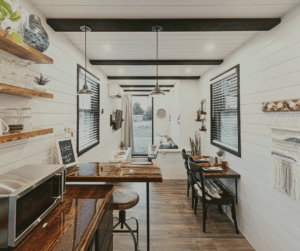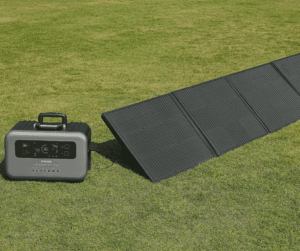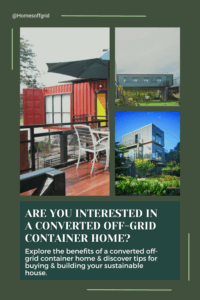Shipping container home conversions have become increasingly popular as an innovative and practical approach to housing, especially for off-grid purposes. Originally built to transport goods across the world, these steel containers are now being repurposed into durable, affordable, and versatile living spaces. Their strong structure, modular design, and availability make them a compelling choice for off-grid living, where sustainability and efficiency are key priorities.
An off-grid shipping container home offers a unique combination of durability and adaptability. These homes can be designed to suit various climates and terrains, making them a viable option for remote locations. With the right modifications, a container home can be fully self-sufficient, integrating renewable energy, water collection, and waste management systems to remove reliance on external utilities.
Explore every stage of the conversion process, from sourcing a container to designing and outfitting it for off-grid living. Whether you’re looking for a compact, minimalist home or a multi-container setup, understanding the benefits and challenges of this building method will help you create a comfortable and functional off-grid space.

Why an Off-Grid Shipping Container Home?
When considering off-grid housing options, shipping containers offer several advantages over more traditional builds, such as timber cabins or earthbag homes. Their steel construction makes them highly durable, able to withstand harsh weather conditions, pests, and even fire. Unlike wooden structures, they require minimal structural reinforcement and can last decades with proper maintenance.
Another key advantage is their modular design. A single container can serve as a compact home, while multiple containers can be joined to create a larger, more complex living space. This flexibility allows for a range of design possibilities, from simple single-story homes to multi-level dwellings with innovative layouts.
Affordability is another major draw. While the cost of a shipping container varies depending on condition, size, and location, they are generally cheaper than traditional building materials. Buying a second-hand container can further reduce costs, though it’s important to inspect it for structural integrity before purchase.
For off-grid living, containers offer a solid foundation for integrating sustainable systems. Their box-like shape makes them ideal for installing solar panels on the roof, while rainwater harvesting systems can be easily added. Insulating a container properly ensures energy efficiency, helping to maintain a comfortable indoor temperature in all seasons.
While converting a shipping container requires careful planning – especially regarding insulation, ventilation, and condensation control – it provides an excellent base for an adaptable and sustainable off-grid home. Their strength, availability, and modularity make them an attractive alternative to conventional off-grid housing options.
Planning and Design
Careful planning and design are crucial when converting a shipping container into an off-grid home. From choosing the right container size to selecting a suitable location, each decision impacts the functionality and efficiency of your living space. Thoughtful design also ensures that your home remains comfortable, sustainable, and compliant with local regulations.
Defining Your Needs
Before purchasing a shipping container, consider how much space you need. A single 20ft or 40ft container can serve as a compact home, ideal for minimalists or those wanting a simple cabin-style setup. If you require more space, multiple containers can be joined together to create a larger layout. Stacking containers or arranging them in an L-shape or U-shape allows for creative floor plans, increasing both functionality and comfort.
Think about how you will use the space. Will you need separate rooms for sleeping, cooking, and working? Do you plan to incorporate an off-grid power system, water storage, or waste-management system? Defining these needs early will help streamline the conversion process and prevent costly modifications later.
Site Selection
Choosing the right location is just as important as designing the container itself. Factors to consider include:
- Accessibility: Ensure the site is reachable by the vehicles delivering your container(s). Remote locations may require additional groundwork to allow for transport and installation.
- Climate: Harsh winters, extreme heat, or high humidity will influence your insulation, ventilation, and energy requirements.
- Local Regulations: Some areas have planning regulations or building codes that dictate where and how a shipping container home can be placed. Always check local policies before purchasing land or starting construction.
- Natural Features: Positioning your home to take advantage of natural sunlight, wind patterns, and rainwater collection can improve energy efficiency and sustainability.
Design Considerations
Once you’ve selected a site and determined your space requirements, focus on optimising your home’s layout and energy efficiency. Good design choices from the start will make your home more comfortable and functional in the long term.
- Maximising Space: Vertical storage, multi-use furniture, and well-placed partitions can help make a small footprint feel more spacious. Some larger containers provide extra headroom, making interiors feel less cramped.
- Enhancing Natural Light: Shipping containers are naturally dark, so incorporating large windows, skylights, or glass doors can improve brightness and ventilation. Consider positioning windows to maximise daylight exposure and passive solar heating.
- Energy Efficiency: Insulation, ventilation, and strategic positioning all play a role in keeping the home comfortable with minimal energy input. Designing for airflow can reduce cooling costs in warm climates, while proper insulation helps retain heat in colder regions.
Taking the time to plan and design your off-grid shipping container home carefully will save time and effort in later stages. By making informed choices early, you’ll create a functional, efficient, and sustainable living space tailored to your needs.
Sourcing Shipping Containers
Selecting the right shipping container is a key step in building an off-grid home. Not all containers are the same, and their condition, type, and source can impact the success of your project. Understanding these factors will help you make an informed decision and avoid costly issues down the line.

Types of Containers
Shipping containers come in different sizes and specifications, each suited to different needs:
- Standard Containers (20ft & 40ft): The most commonly used options, offering a balance between space and affordability. They typically measure 8ft wide and 8.5ft tall.
- High-Cube Containers: Similar to standard containers but with an extra foot of height (9.5ft), making them ideal for those who want more headroom or perhaps a mezzanine sleeping area.
- Refrigerated (Reefer) Containers: Originally designed for transporting perishable goods, these are heavily insulated but require additional modifications for residential use. Their existing insulation can be useful but may need replacing due to chemical treatments.
Choosing the right type depends on your design goals, insulation needs, and budget. High-cube containers are often preferred for homes as they offer greater internal space.
Condition Assessment
New, used, and refurbished containers vary in price and condition. A thorough inspection helps avoid unexpected repairs and ensures a solid foundation for your home conversion. Before purchasing, inspect the container for large dents, rust, or damage to the frame. Small surface rust is common and can be treated, but deep corrosion may weaken the structure. You should also ensure the doors open and close properly, with no warped or broken seals that could allow water ingress. Containers that have transported hazardous chemicals may have residual contamination, making them unsuitable for residential use. Ask for the container’s history if possible. You should also assess the condition of the existing floor as many shipping containers have plywood floors treated with pesticides. Consider replacing them or sealing them with a non-toxic barrier.
Purchasing Options
Shipping containers can be sourced from a variety of suppliers, including:
- Shipping Companies & Depots: Often the best place to find second-hand containers at lower prices.
- Specialist Retailers: Companies that refurbish and modify containers may offer higher-quality options but at a premium.
- Private Sellers: Online marketplaces sometimes have containers for sale, but condition and delivery logistics can be more challenging.
Buying second-hand can be a cost-effective option, but always inspect the container in person or request detailed photos before committing. Also, factor in delivery costs, which can vary depending on location and accessibility.
Site Preparation and Foundations
Preparing the site before placing your shipping container home is essential for ensuring stability, longevity, and efficiency. From clearing the land to choosing a suitable foundation, proper groundwork will set the stage for a successful build.
Site Clearing
Before installing your container, the land needs to be properly prepared. A well-prepared site makes installation smoother and reduces long-term maintenance issues. The first step will be to remove debris and vegetation. Clearing trees, rocks, and uneven ground within the build and access area prevents stability issues. Ensuring the ground is level helps prevent shifting or sinking over time. If the site is prone to flooding, consider raising the foundation or installing drainage channels.
Foundation Types
Unlike traditional homes, shipping containers don’t always require deep foundations, but a solid base is still necessary. Your foundation choice will depend on soil type, budget, and whether you plan to relocate the container in the future. Common foundation types include:
- Concrete Piers: A cost-effective and popular choice, using reinforced concrete blocks at key points under the container for support. Ideal for uneven ground.
- Slab Foundation: A full concrete slab provides excellent stability and prevents shifting but is more expensive and labour-intensive.
- Trench Foundations: Similar to traditional strip foundations, these offer strong support while allowing for better ventilation underneath.
Positioning Containers
Where and how you place your container will affect both functionality and energy efficiency. It is best to position windows and doors to maximise passive solar heating in cold climates and shade in hot areas. You can also make use of natural features like trees or hills to help reduce exposure to strong winds. Meanwhile a north-south orientation is often recommended for better temperature regulation.
Planning your foundation and placement carefully ensures that your shipping container home is not only stable but also comfortable and energy-efficient in the long run.

Structural Modifications
Once you have secured your shipping container and prepared the site, the next step is making the necessary structural modifications to transform it into a functional off-grid home. Cutting openings for doors and windows, connecting multiple containers, and installing a suitable roof all require careful planning to maintain structural integrity and ensure long-term durability.
Cutting and Welding
Creating openings for doors, windows, and internal connections between containers requires precision. Since shipping containers are designed to be structurally strong, cutting into the walls or roof can compromise their integrity if not done correctly. When removing sections of the container, reinforcement may be necessary, particularly around large openings. Welded steel frames or structural reinforcements help redistribute weight and prevent warping. Plasma cutters and angle grinders are commonly used for this work, though professional welders may be needed for more complex modifications.
If you plan to join multiple containers, welding is often the most secure method, though some builders opt for bolted connections for flexibility. Containers can be stacked or arranged side by side, with openings cut to allow interior passage between sections. Reinforcing the connection points ensures stability, particularly in areas with high winds or seismic activity.
Choosing Suitable Windows and Doors
Standard household windows and doors are often the best choice for a shipping container home. Unlike mobile homes or campervans, which require lightweight fixtures designed for movement, a shipping container home remains stationary, allowing for more cost-effective and energy-efficient options. Double- or triple-glazed windows provide insulation benefits, helping to regulate indoor temperatures, while sturdy doors improve security. The placement of windows and doors should be planned to maximise natural light and ventilation, reducing the need for artificial lighting and mechanical cooling.
Roofing Solutions
Shipping containers come with a flat metal roof, which is not designed to handle heavy loads or prolonged exposure to moisture without reinforcement. Adding a secondary roof structure can improve insulation, provide better water runoff, and create space for solar panels or rainwater collection systems. A pitched or sloped roof helps prevent water pooling, reducing the risk of leaks and rust.
In colder climates, an insulated roof helps retain heat, while in warmer areas, an extended overhang can provide shade and reduce interior temperatures. Some owners opt for green roofs with vegetation, which improve insulation and absorb rainwater. The choice of roofing material should align with your climate, budget, and long-term maintenance needs.
Insulation and Temperature Control
Maintaining a comfortable indoor temperature is one of the biggest challenges when converting a shipping container into an off-grid home. The metal walls conduct heat and cold easily, making insulation and ventilation essential. Proper temperature control ensures year-round comfort while reducing energy costs.
Insulation Materials
Choosing the right insulation depends on factors like budget, climate, and installation ease. Spray foam insulation is popular due to its excellent thermal performance and ability to seal gaps, preventing condensation and moisture buildup. Rigid foam boards offer a cost-effective alternative and can be installed on both the interior and exterior walls. Eco-friendly materials like sheep’s wool, hemp, and cork provide sustainable insulation options, though they may require additional vapor barriers to prevent moisture issues. For a detailed comparison of insulation types, click here.
Addressing Thermal Bridges
Metal is highly conductive, meaning heat can escape in cold weather and enter in warm conditions through uninsulated areas. These weak points, known as thermal bridges, can significantly impact energy efficiency. To minimise heat loss, insulation should be continuous, covering all metal surfaces, including the container’s framing. External insulation is often more effective at preventing thermal bridging than internal insulation, though it requires additional weatherproofing. Insulating the floor and ceiling is equally important, as heat can be lost through both surfaces.
Ventilation Systems
Without proper airflow, a shipping container home can suffer from condensation, mould growth, and poor air quality. Ventilation strategies should balance fresh air intake with moisture control. Passive ventilation, such as strategically placed vents, louvres, and operable windows, can help regulate airflow naturally. In more humid environments, mechanical ventilation, like extractor fans or heat recovery ventilation (HRV) systems, may be necessary to maintain indoor air quality. If using a wood stove or other combustion-based heating, proper venting is crucial to ensure safe operation.
By incorporating effective insulation and ventilation, you can create a shipping container home that remains comfortable in all seasons while minimising energy use.
Interior Build-Out
Once the structural modifications are complete, the next step is transforming the inside of the container into a functional living space. The interior build-out involves framing walls, installing any interior insulation, and selecting suitable flooring and wall materials. Since shipping containers are made of metal, certain considerations – such as preventing condensation and ensuring secure attachment points – are crucial to creating a comfortable and durable home.

Framing and Walls
Internal framing provides structure for insulation, wiring, and wall finishes. Since shipping containers have a metal shell, traditional wood framing can be used, but it must be secured properly to the steel walls. Metal studs are another option, offering fire resistance and improved durability in humid conditions. The framing layout should accommodate insulation while maintaining sufficient airflow to prevent condensation buildup. When selecting wall materials, lightweight but durable options like plywood, plasterboard, or composite panels work well. Vapour barriers may also be necessary, particularly in humid climates, to prevent moisture from damaging interior finishes.
Flooring Options
Shipping container floors are often made of marine plywood, which may be treated with chemicals to prevent pests and rot. Before installing new flooring, it’s important to seal or replace the original plywood to prevent exposure to any residual chemicals. Common flooring choices include engineered wood, laminate, vinyl planks, or even reclaimed timber, depending on budget and aesthetic preferences. A well-insulated subfloor helps reduce heat loss and improves comfort, particularly in colder climates. If moisture resistance is a priority, cork or composite materials provide a durable, water-resistant solution.
Off-Grid Systems Integration
Integrating off-grid systems ensures a self-sufficient and sustainable shipping container home. This includes generating electricity, sourcing and treating water, and managing waste efficiently. While each of these topics is covered in more detail in other articles, here is a brief overview of the key considerations.
Off-grid electricity generation typically relies on solar panels, wind turbines, or micro-hydro systems, depending on location and energy needs. Battery storage is essential for maintaining a reliable power supply, especially in remote areas where grid access is unavailable. Water collection and treatment systems often include rainwater harvesting, filtration, and purification to ensure a safe and consistent water source. Managing wastewater effectively is equally important, with options such as composting toilets, greywater recycling, and septic systems providing sustainable solutions.
Deciding on which systems to integrate is essential to create a sustainable and self-sufficient home.
Maintenance and Longevity
A well-maintained shipping container home can last for decades, but regular upkeep is necessary to prevent structural degradation. Exposure to the elements, wear from daily use, and the performance of off-grid systems all require ongoing attention. Developing a maintenance schedule helps preserve the home’s condition while reducing costly repairs over time.
Routine Inspections
Regular inspections help identify potential issues before they become serious problems. Checking for rust, leaks, or insulation damage ensures that the structure remains weatherproof. The roof, in particular, should be inspected for standing water or signs of corrosion. Off-grid systems, including solar panels, batteries, and water filtration setups, should also be monitored to ensure they function efficiently. Addressing minor concerns early can extend the lifespan of both the container and its internal systems.
Protective Measures
The exterior of a shipping container home plays a crucial role in protecting the structure from the elements while also influencing its visual appeal. Choosing the right finishes enhances durability, improves insulation, and helps blend the home into its surroundings.
Since shipping containers are made from corten steel, they are designed to resist corrosion, but exposure to moisture over time can still lead to rust. Applying protective coatings helps extend the lifespan of the structure. Rust-resistant primers and high-quality exterior paints create a durable seal against the elements, while reflective coatings can reduce heat absorption in hot climates. If maintaining the original container aesthetic, a fresh coat of marine-grade paint provides both protection and a clean finish.
Applying external cladding, such as wooden boards or fibreglass board, is one of the most effective ways to protect a shipping container from weather-related wear while improving its overall appearance. Cladding also improves insulation by reducing heat gain in summer and heat loss in winter, particularly when combined with other insulation layers.
Reapplying protective coatings, maintaining cladding, checking seals around doors and windows, and maintaining proper drainage around the site all help to preserve the container’s integrity.
Upgrades and Scalability
As needs evolve, expanding or upgrading a container home may become a priority. Additional insulation, improved energy systems, or extended living space can enhance comfort and efficiency. If you plan to add more containers, ensuring the original structure is designed for future expansion makes modifications easier. Upgrading off-grid systems, such as increasing battery capacity or improving water storage, also enhances long-term sustainability. A well-planned container home allows for adaptability, ensuring it remains a functional and comfortable space for years to come.

Regulatory and Legal Considerations
Before moving forward with a shipping container home, it’s essential to understand the legal requirements that may apply to your project. Regulations vary widely depending on location, and failing to comply with them can result in fines or even the need to dismantle your home. Whether you’re placing your container on rural land or within an urban setting, securing the necessary permits and ensuring compliance with planning laws will save time and trouble in the long run.
Building Permits
Most regions require building permits for permanent residential structures, including those made from shipping containers. The approval process typically involves submitting detailed plans that outline the foundation, structural modifications, insulation, and off-grid systems. Some authorities may require engineering reports to ensure the container’s modifications do not compromise its integrity. If you plan to live in the container temporarily, such as on a construction site or as an accessory dwelling, different regulations may apply. Consulting with local building authorities early in the process can clarify requirements and prevent setbacks.
Zoning Laws and Planning Permissions
Even if a shipping container home meets building codes, zoning laws or planning permissions may restrict where it can be placed. Some areas classify container homes as temporary structures, while others require them to meet conventional housing standards. Rural locations often have more flexibility, but it’s important to confirm whether residential use is allowed. If the land is designated for agricultural or commercial use, additional permissions may be required. Off-grid considerations, such as water collection and waste disposal, may also be subject to local restrictions. Engaging with local councils or planning offices can provide clarity on whether your chosen site is suitable.
Environmental Compliance
Off-grid homes, particularly those in ecologically sensitive areas, must adhere to environmental regulations designed to protect local ecosystems. Water use, waste disposal, and land impact are common areas of scrutiny. Some jurisdictions impose restrictions on rainwater collection or septic system placement, particularly if the property is near a water source. In some cases, additional environmental assessments may be required before construction is approved. Ensuring that your home meets sustainability standards not only helps secure necessary approvals but also contributes to responsible off-grid living.
Conclusion
Converting a shipping container into an off-grid home offers a practical, sustainable, and cost-effective way to embrace self-sufficiency. The strength and modularity of containers make them an ideal choice for creating a resilient and adaptable living space, whether you’re aiming for a compact tiny home or a larger, multi-container setup. With the right planning, modifications, and off-grid systems, you can create a comfortable, energy-efficient environment that reduces your reliance on external utilities.
By understanding the various steps involved – from sourcing the container to integrating essential systems – you can embark on the journey of building your off-grid home with confidence. With its numerous benefits, including durability, affordability, and versatility, a shipping container can provide the foundation for a truly sustainable lifestyle. Whether you’re just starting out, or looking to expand your off-grid knowledge, now is the perfect time to explore this innovative housing option.

To find out more about off-grid living return to our Reading Room.


